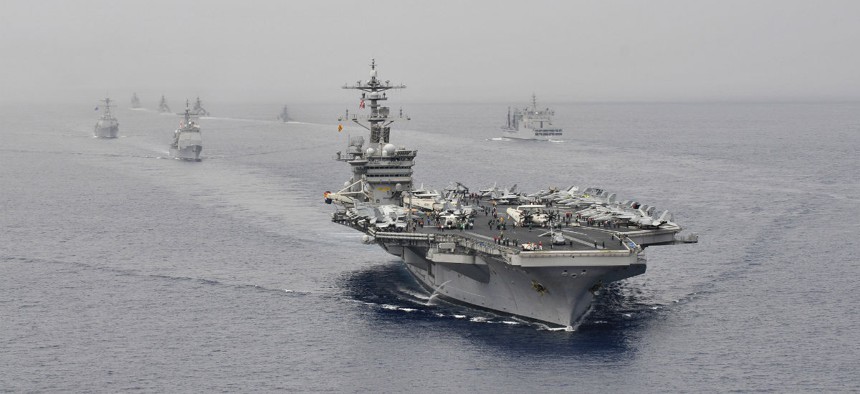Navy’s Forthcoming Cyber Strategy Aims for Global Capability

USS Carl Vinson and U.S. and Indian navy ships in an April 2012 passing exercise. U.S. Navy photo by Mass Communication Specialist Seaman George M. Bell
A soon-to-come cyber strategy will focus on building the force’s capacity to conduct cyberattacks from anywhere around the Earth.
Executing hack attacks to support maritime missions will take the Navy out of its traditional comfort zone at the intersection of the land and the sea.
Part of a soon-to-be-released cyber strategy will focus on building the force’s capacity to conduct cyberattacks from anywhere around the Earth, said Kevin Cooley, executive director and command information officer of Fleet Cyber Command.
“There's not necessarily a direct correlation between the capabilities of a team to exercise cyberwarfare offense and having those people necessarily on ships," he told Nextgov at the 14th Annual C4ISR & Networks Conference in Arlington, Virginia. "Teams are structured in such a way that their locations can be shifted based on missions.”
He added, "Those kinds of capabilities are leveraged from all parts of the world, predominantly ashore installations, in some cases afloat."
The overall strategy Cooley discussed during a panel at the event also includes, among other things, maintaining command and control of naval networks, reducing points of entry for adversary hackers and collecting signals intelligence.
The new approach follows the launch of “Task Force Cyber Awakening,” a working group established last fall to update information security servicewide, from Windows XP-based office systems to next-generation combat systems.
Carrying out cyber offensives presents a conundrum for a service accustomed to projecting power along coastal waters, some academics say.
"No longer will its bases, battle groups, forward infrastructure, and allied navies be immune just because they are over the horizon or far from the battle space," military researchers Peter Dombrowski and Chris C. Demchak said in a spring 2014 Naval War College report.
But at the same time, the Navy is well-positioned to take on the digital realm with skills honed during electronic warfare, they added.
Also, the force "has a long established cultural acceptance of the deception, masking, mobility and improvised independent operations that deployed ships have needed for survival in peace as well as war,” the researchers said. At sea, military dominance might be measured by "what one keeps the enemy from easily knowing and how abruptly one can emerge in the enemy’s near proximity than of what beach needs to be crossed.”
It is conceivable naval cyber troops deployed onboard might assist on a mission by protecting communications while a commander plans a missile strike or they may degrade an enemy ship’s communications.
Any orders to execute cyber capabilities would come from U.S. Cyber Command, which oversees all cyber offensive and defensive activities, Cooley said. The current head of CYBERCOM, Adm. Mike Rogers, served as the commander of Cooley’s fleet before taking office.
While there, Rogers supervised the response to a major hack, allegedly perpetrated by Iran, against the Navy Marine Corps Intranet.



